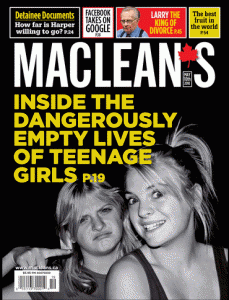Margin of Error #4: Inside Maclean's dangerously empty statistics on teenagers
allison martell
 The online version of Maclean’s recent piece on young women really doesn’t do the print version justice. “Inside the Dangerously Empty Lives of Teenage Girls” was splashed across the cover, along with two dangerously empty looking girls. As usual, the cover suggested something more comprehensive and controversial than the actual article inside the magazine—in this case, a Q&A with Leonard Sax, a retired MD and advocate for single-sex education.
The online version of Maclean’s recent piece on young women really doesn’t do the print version justice. “Inside the Dangerously Empty Lives of Teenage Girls” was splashed across the cover, along with two dangerously empty looking girls. As usual, the cover suggested something more comprehensive and controversial than the actual article inside the magazine—in this case, a Q&A with Leonard Sax, a retired MD and advocate for single-sex education.
If Maclean’s was looking for someone to explain Canada’s teenage girls to their parents, Sax was a strange choice. He does have a PhD in psychology from 1980, but he primarily interprets and popularizes research rather than doing peer-reviewed work himself. Unfortunately, his interpretations are pretty controversial.
A blog called Language Log has criticized Sax for over-interpreting and distorting research on gender differences. This stands out to me because I know Language Log to be home to particularly smart take-downs of bad statistics. The New York Times also published a fairly critical profile of Sax a couple years ago.
So I shouldn’t be surprised to find Sax up to his usual tricks in this Q&A. Take his claims about self injury:
…if you look at the literature, you see that more than one in five girls is cutting herself and/or burning herself with matches. […] In a very well-executed study published in the Canadian Medical Association Journal two years ago, a demographically representative sample of young people 14 to 21 years of age was surveyed in Victoria, and there was an overall prevalence of roughly 16 percent. Although in the abstract there’s no mention of sex differences, if you pull up the tables you see that only eight percent of boys but 24 percent of girls were cutting or burning themselves.
In fact, that’s not exactly what the paper found. (You can read it here.) Sixteen percent of young people and 24 percent of girls had, at some time, injured themselves. But the way this statistic is repeated presents two problems. First, Sax implies that all self injury in these papers is cutting or burning, when in fact the authors also measured some kinds of drug and alcohol use, and other behaviours. This is an understandable memory lapse. But second, and more importantly, Sax’s statistics are for youth who had ever hurt themselves. When we look at how many youth had injured themselves more than three times, prevalence falls to six percent. (The paper doesn’t provide a gender breakdown for that smaller group.)
The difficulty here is Sax’s verb tense. The fact that he says “one in five girls is” and then later “24 percent of girls were” suggests an ongoing, long-term problem. As unpleasant as it is to imagine, I think we can accept that a large number of teenagers try out self harm, and that this is quite different from someone who injures repeatedly, over a long period of time. It is the latter scenario that Sax goes on to describe in titillating detail:
The girls themselves tell you, “I cut myself because it’s real, it’s not fake.” It’s not a cry for help: most girls don’t want adults knowing they’re cutting, which is why they cut in places we won’t see, like high up on the inner thigh. And they don’t want to kill themselves. There’s research which is quite astonishing to many people: when girls cut themselves, they are getting a release of endogenous opiates—they’re actually getting high.
This is a small misinterpretation, but it is important. A surprising result has unusual power in this sort of piece—it stops readers short, overturns their assumptions, and encourages them to reassess the rest of the article’s claims. And it’s especially disappointing coming from a magazine that just last year published a comprehensive package on how well teenagers are doing:
In light of these facts, [Reginald] Bibby [sociology at the University of Lethbridge] expects strong resistance to his findings from the very teen crisis apparatus he partially credits with all the good news. “The experts act almost annoyed when you suggest kids are actually looking a little better,” he says. Some of that blowback stems from genuine difference of opinion. But a lot grows out of popular wisdom coming out of the United States.
Unfortunately, with this piece Maclean’s has uncritically repeated that misleading popular wisdom. And from a cover this sensationalist, I think we have a right to expect more.